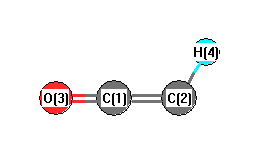Jump to
S1C2
Energy calculated at MP2/CEP-31G
| | hartrees |
|---|
| Energy at 0K | -27.298817 |
| Energy at 298.15K | |
| HF Energy | -27.068356 |
| Nuclear repulsion energy | 25.886320 |
The energy at 298.15K was derived from the energy at 0K
and an integrated heat capacity that used the calculated vibrational frequencies.
Vibrational Frequencies calculated at MP2/CEP-31G
| Mode Number |
Symmetry |
Frequency
(cm-1) |
Scaled Frequency
(cm-1) |
IR Intensities
(km mol-1) |
Raman Act
(Å4/u) |
Dep P |
Dep U |
|---|
| 1 |
Σ |
3506 |
3388 |
172.25 |
121.71 |
0.36 |
0.53 |
| 2 |
Σ |
2059 |
1990 |
715.13 |
1076.11 |
0.37 |
0.54 |
| 3 |
Σ |
1626 |
1571 |
15.69 |
486.66 |
0.29 |
0.45 |
| 4 |
Π |
679 |
656 |
1.18 |
1.00 |
0.75 |
0.86 |
| 4 |
Π |
584 |
565 |
15.67 |
0.15 |
0.75 |
0.86 |
| 5 |
Π |
561 |
542 |
44.68 |
7.03 |
0.75 |
0.86 |
| 5 |
Π |
195 |
188 |
335.68 |
17.93 |
0.75 |
0.86 |
Unscaled Zero Point Vibrational Energy (zpe) 4605.2 cm
-1
Scaled (by 0.9663) Zero Point Vibrational Energy (zpe) 4450.0 cm
-1
See section
III.C.1 List or set vibrational scaling factors
to change the scale factors used here.
See section
III.C.2
Calculate a vibrational scaling factor for a given set of molecules
to determine the least squares best scaling factor.
Geometric Data calculated at MP2/CEP-31G
Point Group is C∞v
Cartesians (Å)
| Atom |
x (Å) |
y (Å) |
z (Å) |
|---|
| C1 |
0.000 |
0.000 |
0.028 |
| C2 |
0.000 |
0.000 |
-1.276 |
| O3 |
0.000 |
0.000 |
1.229 |
| H4 |
0.000 |
0.000 |
-2.349 |
Atom - Atom Distances (Å)
| |
C1 |
C2 |
O3 |
H4 |
| C1 | | 1.3038 | 1.2013 | 2.3769 |
C2 | 1.3038 | | 2.5051 | 1.0731 | O3 | 1.2013 | 2.5051 | | 3.5782 | H4 | 2.3769 | 1.0731 | 3.5782 | |
 More geometry information
More geometry information
Calculated Bond Angles
| atom1 |
atom2 |
atom3 |
angle |
|
atom1 |
atom2 |
atom3 |
angle |
| C1 |
C2 |
H4 |
180.000 |
|
C2 |
C1 |
O3 |
180.000 |
Electronic energy levels
Charges, Dipole, Quadrupole and Polarizability
Jump to
S1C1
Energy calculated at MP2/CEP-31G
| | hartrees |
|---|
| Energy at 0K | -27.307136 |
| Energy at 298.15K | |
| HF Energy | -27.051720 |
| Nuclear repulsion energy | 25.435676 |
The energy at 298.15K was derived from the energy at 0K
and an integrated heat capacity that used the calculated vibrational frequencies.
Vibrational Frequencies calculated at MP2/CEP-31G
| Mode Number |
Symmetry |
Frequency
(cm-1) |
Scaled Frequency
(cm-1) |
IR Intensities
(km mol-1) |
Raman Act
(Å4/u) |
Dep P |
Dep U |
|---|
| 1 |
A' |
3345 |
3232 |
9104.55 |
3282347.00 |
0.34 |
0.51 |
| 2 |
A' |
2996 |
2895 |
981.72 |
479028.10 |
0.35 |
0.52 |
| 3 |
A' |
1542 |
1490 |
3726.97 |
685164.30 |
0.35 |
0.52 |
| 4 |
A' |
943 |
911 |
80.25 |
9751.30 |
0.34 |
0.50 |
| 5 |
A' |
736 |
712 |
216.10 |
33147.54 |
0.35 |
0.52 |
| 6 |
A" |
449 |
434 |
16.50 |
1887.04 |
0.75 |
0.86 |
Unscaled Zero Point Vibrational Energy (zpe) 5005.1 cm
-1
Scaled (by 0.9663) Zero Point Vibrational Energy (zpe) 4836.4 cm
-1
See section
III.C.1 List or set vibrational scaling factors
to change the scale factors used here.
See section
III.C.2
Calculate a vibrational scaling factor for a given set of molecules
to determine the least squares best scaling factor.
Geometric Data calculated at MP2/CEP-31G
Point Group is Cs
Cartesians (Å)
| Atom |
x (Å) |
y (Å) |
z (Å) |
|---|
| C1 |
0.000 |
0.048 |
0.000 |
| C2 |
0.467 |
-1.295 |
0.000 |
| O3 |
-0.549 |
1.099 |
0.000 |
| H4 |
1.587 |
-1.307 |
0.000 |
Atom - Atom Distances (Å)
| |
C1 |
C2 |
O3 |
H4 |
| C1 | | 1.4222 | 1.1860 | 2.0869 |
C2 | 1.4222 | | 2.6012 | 1.1200 | O3 | 1.1860 | 2.6012 | | 3.2177 | H4 | 2.0869 | 1.1200 | 3.2177 | |
 More geometry information
More geometry information
Calculated Bond Angles
| atom1 |
atom2 |
atom3 |
angle |
|
atom1 |
atom2 |
atom3 |
angle |
| C1 |
C2 |
H4 |
109.789 |
|
C2 |
C1 |
O3 |
171.616 |
Electronic energy levels
Charges, Dipole, Quadrupole and Polarizability
